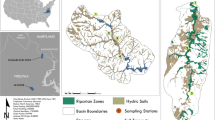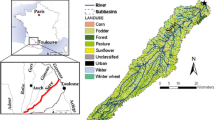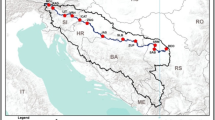Abstract
Purpose
Floodwaters contain a mixture of organic contaminants which affect both the water and soil quality within flooded regions. This study is the first to describe the chemical behavior of organic contaminants mobilized during the 2010 flooding event of the Rio Grande. The study compares two sites: one directly impacted by outfall from municipal sources and one primarily impacted by rural runoff.
Materials and methods
This study characterized the in situ cycling of organic contaminants (triclosan, ciprofloxacin, and atrazine), their depositional mechanisms, and the post-flood dynamics within riparian soils over 6 months. Water quality (pH, salinity, alkalinity, turbidity, N, and P) of the Rio Grande at four sites within Webb County, TX, was monitored for 3 months pre-flooding and 6 months post-flooding in order to determine contaminant levels along the Webb County border. Soil physicochemical properties (pH, CEC, and EC) were assessed for 6 months at two sites post-flooding: within the municipal area of both Laredo, TX, USA, and Nuevo Laredo, Mexico (LCC site), and upstream of the site near the edge of Laredo, TX (MR site).
Results and discussion
Low levels of contaminants were detected in the watershed year-round with levels increasing during the flood. Floodwaters had a lower pH than nonflooding conditions, resulting in greater partitioning of both triclosan and ciprofloxacin to particles within the water column with no change detected in atrazine behavior. Soil samples (0–2-cm depth) showed an increase in clay-sized particles (up to 6–14 %) and contaminant concentrations similar to that of water column particles. Organic contaminants were uniform in concentration throughout the soil profile (2–30 cm), demonstrating the impact of infiltration. Both triclosan and atrazine decayed away at rates of 23 ± 2 and 16 ± 1 days, respectively, with no decay of ciprofloxacin detected. Vertical mobility of contaminants within soils was not detected.
Conclusions
This study was able to distinguish the influx of contamination contributed by particle deposition from that due to infiltration of the contaminated floodwaters. Further, our data indicates that outfall/effluent contaminants, such as ciprofloxacin, may persist in riparian soils post-flooding. Agricultural management should consider potential exposure and accumulation of floodwater contaminants in crops.





Similar content being viewed by others
References
Al-Rajab AJ, Sabourin L, Scott A, Lapen DR, Topp E (2009) Impact of biosolids on the persistence and dissipation pathways of triclosan and triclocarbon in an agricultural soil. Sci Total Environ 407:5978–5985
Barnes KK, Kolpin DW, Furlong ET, Zaugg SD, Meyer MT, Barber LB (2008) A national reconnaissance of pharmaceuticals and other organic wastewater contaminants in the United States – I) Groundwater. Sci Total Environ 402:192–200
Basta NT, Huhnke RL, Stiegler JH (1997) Atrazine runoff from conservation tillage systems: a simulated rainfall study. J Soil Water 52:44–48
Burhenne J, Ludwig M, Nikoloudis P, Spiteller M (1997) Photolytic degradation of fluoroquinolone carboxylic acids in aqueous solution. Primary photoproducts and half-lives. Environ Sci Pollut R 4:10–15
Cantwell M, Wilson B, Zhu J, King J, Wallace G, Smith J, Olsen C, Burgess R (2010) Temporal trends of triclosan contamination in dated sediment cores from four urbanized estuaries: evidence of preservation and accumulation. Chemosphere 78:347–352
Carr DL, Morse AN, GZak JC, Anderson TA (2011) Microbially mediated degradation of common pharmaceuticals and personal care products in soil under aerobic and reduced oxygen conditions. Water Air Soil Pollut 216:633–642
Chapman HD (1965) Cation exchange capacity. In: Black CA (ed) Methods of soil analysis. Part 2: Chemical and microbiological properties. 1965. ASA, CCSA, and SSSA, Madison, pp 891–900
Chong SK, Klubek BP, Weber JT (1998) Herbicide contamination by the 1993 great flood along the Mississippi river. J Amer Water Resour Assoc 34:687–693
Cobb GP, Abel MT, Rainwater TR, Austin GP, Cox SB, Kendall RJ, Marsland EJ, Anderson TA, Leftwich BD, Zak JC, Presley SM (2006) Metal distributions in New Orleans following hurricanes Katrina and Rita: a continuation study. Environ Sci Technol 40:4571–4577
Cooper C, Smith S, Moore M (2003) Surface water, ground water and sediment quality in three oxbow lake watersheds in the Mississippi delta agriculture region: pesticides. Int J Ecol Environ Sci 29:171–184
Daughton CG, Ternes TA (1999) Pharmaceuticals and personal care products in the environment: agents of subtle change. Environ Health Perspect 107:907–936
Drury B, Scott J, Rosi-Marshall EJ, Kelly JJ (2013) Triclosan exposure increases triclosan resistance and influences taxonomic composition of benthic bacterial communities. Environ Sci Technol 47:8923–8930
Eisenreich S, Schottler S, Hines N (1994) Standard operating procedure for isolation, extraction and analysis of atrazine, DEA and DIA. Rutgers University P.O. Box 231 New Brunswick, NJ 08903
FEMA (2014) Flood map service center. http://msc.fema.gov/portal, accessed June 2014
Focazio MJ, Kolpin DW, Barnes KK, Furlong ET, Meyer MT, Zaugg SD, Meyer MT, Barber LB (2008) A national reconnaissance of pharmaceuticals and other organic wastewater contaminants in the United States—II) Untreated drinking water sources. Sci Total Environ 402:201–216
Forstner U, Heise S, Schwartz R, Westrich B, Ahlf W (2004) Historical contaminated sediments and soils at the river basin scale. J Soils Sediments 4:247–260
Gee, GW, Bauder, JW (1982) Cation-Exchange Capacity. In Klut A (ed) Methods of soil analysis. Part1, physical and mineralogical methods. Am Soc Agron, Inc., Madison, WI, pp 383–411
Golet E, Alder A, Hartmann A, Ternes T, and Giger W (2001) Trace determination of fluoroquinolone antibacterial agents in urban wastewater by solid-phase extraction and liquid chromatography with fluorescence detection. Anal Chem 73:3632–3638
Golet EM, Xifra I, Siegrist H, Alder AC, Giger W (2003) Environmental exposure assessment of fluoroquinolone antibacterial agents from sewage to soil. Environ Sci Technol 37:3243–3249
Halling-Sørensen B, Nielsen SN, Lanzky PF, Holten Lützhøft H-C, Jorgensen SE (1998) Occurrence, fate and effects of pharmaceutical substances in the environment. Chemosphere 36:357–393
Halling-Sørensen B, Holten Lützhøft H-C, Andersen HR, Ingerslev F (2000) Environmental risk assessment of antibiotics: comparison of mecillinam, trimethoprim and ciprofloxacin. J Antimicrob Chemother 46:53–58
Halling-Sørensen B, Sengeløv G, Ingerslev F, Jensen LB (2003) Reduced antimicrobial potencies of oxytetracycline, tylosin, sulfadiazine, streptomycin, ciprofloxacin, and olaquindox due to environmental process. Arch Environ Contam Toxicol 44:7–16
Hamers T, van den Berg JHJ, van Gestel CAM, van Schooten FJ, Murk AJ (2006) Risk assessment of metals and organic pollutants for herbivorous and carnivorous small mammal food chains in a polluted floodplain (Biesbosch, The Netherlands). Environ Pollut 144:581–595
Hari A, Paruchuri R, Sabatini D, Kibby T (2005) Effects of pH and cationic and nonionic surfactants on the adsorption of pharmaceuticals to a natural aquifer material. Environ Sci Technol 39:2592–2598
Harmon SM, Wyatt DE (2008) Evaluation of post-Katrina flooded soils for contaminants and toxicity to the soil invertebrates Eisenia fetida and Caenorhabditis elegans. Chemosphere 70:1857–1864
Hilscherova K, Dusek L, Kubik V, Cupr P, Hofman J, Klanova J, Holoubek I (2007) Redistribution of organic pollutants in river sediments and alluvial soils related to major floods. J Soils Sediments 7:167–177
Hinther A, Broomba CM, Wulff JE, Helbing CC (2011) Effects of triclocarban, triclosan, and methyl triclosan on thyroid hormone action and stress in frog and mammalian culture systems. Environ Sci Technol 45:5395–5402
Kolpin DW, Furlon ET, Meyer MT, Thurman EM, Zaugg SD, Barber LB, Buxton HT (2002) Pharmaceuticals, hormones, and other organic wastewater contaminants in U.S. streams, a national reconnaissance. Environ Sci Technol 36:1202–1211
Kooistra L, Salas EAL, Clevers JGPW, Wehren R, Leuven RSEW, Nienhuis PH, Buydens LMC (2004) Exploring field vegetation reflectance as an indicator of soil contamination in river floodplains. Environ Pollut 127:281–290
Kummerer K (2009) Antibiotics in the aquatic environment—a review—Part I. Chemosphere 75:417–434
Lee HB, Peart TE, Svoboda ML (2007) Determination of ofloxacin, norfloxacin, and ciprofloxacin in sewage by selective solid-phase extraction, liquid chromatography with fluorescence detection and liquid chromatography – tandem mass spectrometry. J Chromatrography 1139:45–52
Lozano N, Rice CP, Ramirez M, Torrents A (2010) Fate of triclosan in agricultural soils after biosolid applications. Chemosphere 78:760–766
Lupi C, Bucchi AR, Piccioni A, Zapponi GA (1988) The environmental behavior of chemicals in soil: atrazine as an example. Ecotox Environ Safe 16:133–142
Micić VI, Kruge MA, Hofmann T (2013) Variations of common riverine contaminants in reservoir sediments. Sci Total Environ 458–460:90–100
Montero R (2010) Hurricane Alex flood operations, lower Rio Grande flood control project, 2010. International Boundary and Water Commission, Control Lower Rio Grande Citizens Forum, El Paso, TX, USA
Nowara A, Buhrenne J, Spiteller M (1997) Binding of fluoroquinolone carboxylic acid derivatives to clay minerals. J Agric Food Chem 45:1459–1463
Pereira VJ, Linden KG, Weinberg HS (2007) Evaluation of UV for photolytic and oxidative degradation of pharmaceutical compounds in water. Water Res 41:4413–4423
Pico Y, Andreu V (2007) Fluoroquinolones in soil—risks and challenges. Anal Bioanal Chem 387:1287–1299
Pierzynski GM (ed) (2000) Methods of phosphorous analysis for soils, sediments, residuals, and waters. Southern Cooperative Series Bulletin 396
Pimentel D (2009) Environmental and economic costs of the application of pesticides primarily in the United States. Environ Dev Sustain 7:229–252
Pizzuto JE (1987) Sediment diffusion during overbank flows. Sedimentology 34:301–331
Robberson K, Waghe A, Sabatini D, Butler E (2006) Adsorption of the quinolone antibiotic nalidixic acid onto anion-exchange and neutral polymers. Chemosphere 63:934–941
Schultz M, Buttner O, Barorowski M, Bohme M, Matthies M, von Tumpling W (2009) A dynamic model to simulate arsenic, lead and mercury contamination in the terrestrial environment during extreme floods of rivers. Clean - Soil Air Water 37:209–217
Schwartz R, Gerth J, Neumann-Hensel H, Forstner U (2006) Assessment of highly polluted fluvisol in the Spittelwasser floodplain based on national guideline values and MNA-criteria. J Soils Sediments 6:145–155
Scianna J, Logar R, Pick T (2007) Testing and interpreting salt-affected soil for tree and shrub planting, Plant Materials Technical Note No. MT-60. United States Department of Agriculture, Natural Resources Conservation Service, Plant Materials Center, Bridger, MT, USA
Stewart MD, Bates PD, Price DA, Burt TP (1998) Modelling the spatial variability in floodplain soil contamination during flood events to improve chemical mass balance estimates. Hydro Proc 12:1233–1255
Svenningsen H, Henriksen T, Prieme A, Johnsen AR (2011) Triclosan affects the microbial community in simulated sewagedrain-field soil and slows down xenobiotic degradation. Environ Pollut 159:1599–1605
Thelin GP, Stone WW (2010) Method for Estimating Annual Atrazine Use for Counties in the Conterminous United States, 1992–2007: Scientific Investigations Report 2010. US Geological Survey, Washington, DC, USA
USEPA (2009) Occurrence of contaminants of emerging concern in wastewater from nine publicly owned treatment works, EPA-821-R-09-009. Environmental Protection Agency, Office of Water (4303T), Washington, DC, USA
Vasudevan D, Bruland GL, Torrance BS, Upchurch VG, MacKay AA (2009) pH-dependent ciprofloxacin sorption to soils: interaction mechanisms and soil factors influencing sorption. Geoderma 151:68–76
Wallace G, Oktay S, Pala F, Ferraro M, Gnatek M, Luce D (2004) Determination of recent inputs of mercury to lakes/ponds in the Merrimack Valley using sediment cores: a feasibility study. Final report for Massachusetts Department of Environmental Protection. University of Massachusetts, Boston, MA, USA
Wilson B, Smith V, deNoyelles J, Larive C (2003) The effects of three pharmaceutical and personal care products on natural freshwater algal assemblages. Environ Sci Technol 37:1713–1719
Wilson BA, Chen R, Olsen C, Cantwell M, Gontz A, Zhu J (2009) The partitioning of triclosan between aqueous and particulate bound phases in the Hudson River Estuary. Mar Pollut Bull 59:207–212
Xia K, Bhandari A, Das K, Pillar G (2005) Occurrence and fate of pharmaceuticals and personal care products (PPCPs) in biosolids. J Environ Qual 34:91–104
Xu J, Wu L, Chang AC (2009) Degradation and adsorption of selected pharmaceuticals and personal care products (PPCPs) in agricultural soils. Chemosphere 77:1299–1305
Ying GG, Yu XY, Kookana RS (2007) Biological degradation of triclocarban and triclosan in a soil under aerobic and anaerobic conditions and comparison with environmental fate modeling. Environ Pollut 150:300–305
Acknowledgments
We would like to thank our undergraduate research students for their work throughout this project. A sampling of this magnitude is not possible without a strong group of contributing individuals. This includes Cynthia de le Miyar, Anna Garza, Keith Almeida, Adrian Villarreal, Paulina Gonzalez, Maria Gallegos, Melissa Espino, Erik Perez, Raul Castro, Ediza Martinez, Edwin Rodriguez, and Melissa Rodela. We would also like to thank the National Science Foundation for supporting this research (#EAR 1054466).
Author information
Authors and Affiliations
Corresponding author
Additional information
Responsible editor: Jianming Xu
Rights and permissions
About this article
Cite this article
Wilson, B.A., Addo-Mensah, A.K. & Mendez, M.O. In situ impacts of a flooding event on contaminant deposition and fate in a riparian ecosystem. J Soils Sediments 15, 2244–2256 (2015). https://doi.org/10.1007/s11368-015-1145-z
Received:
Accepted:
Published:
Issue Date:
DOI: https://doi.org/10.1007/s11368-015-1145-z




